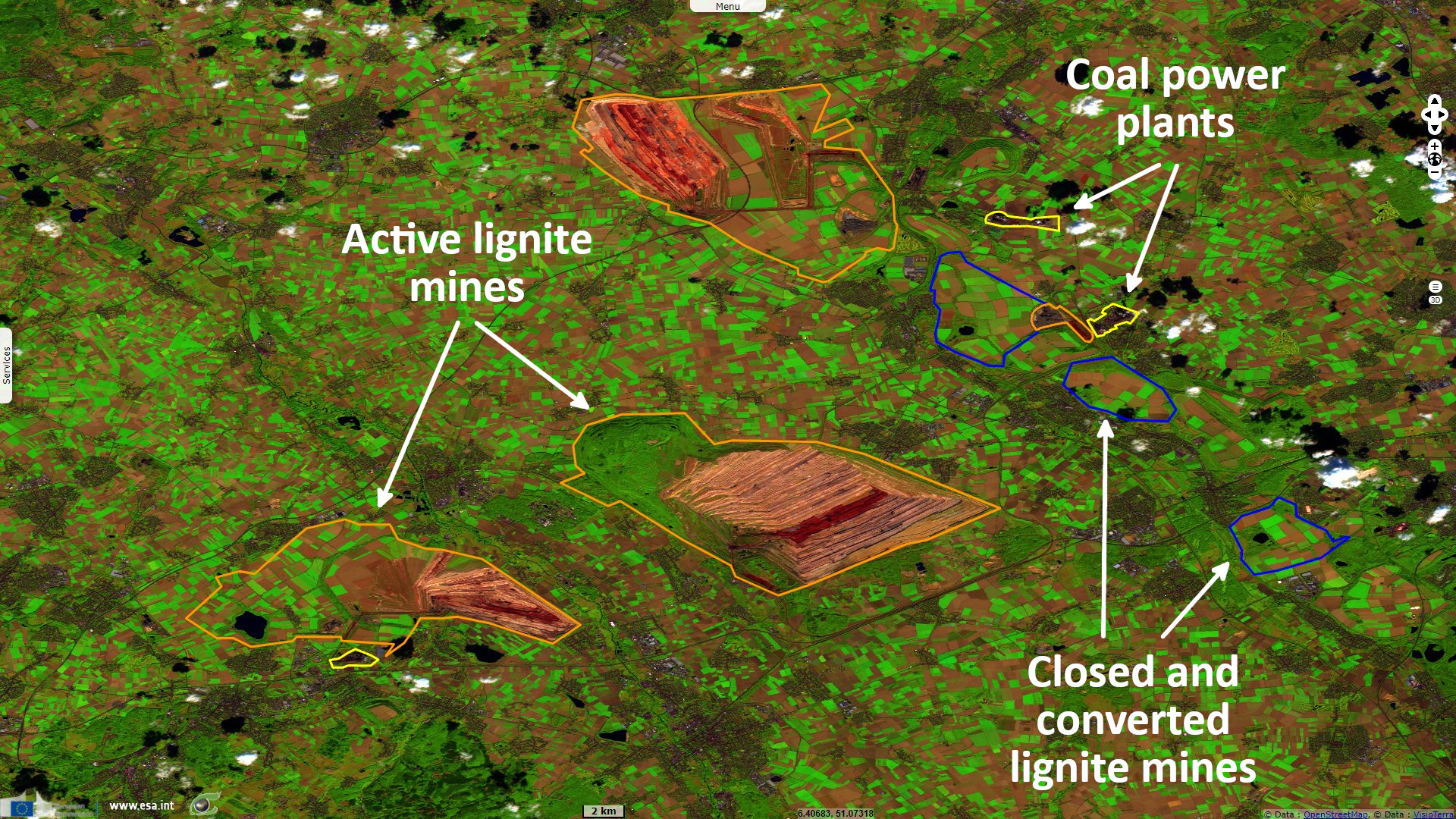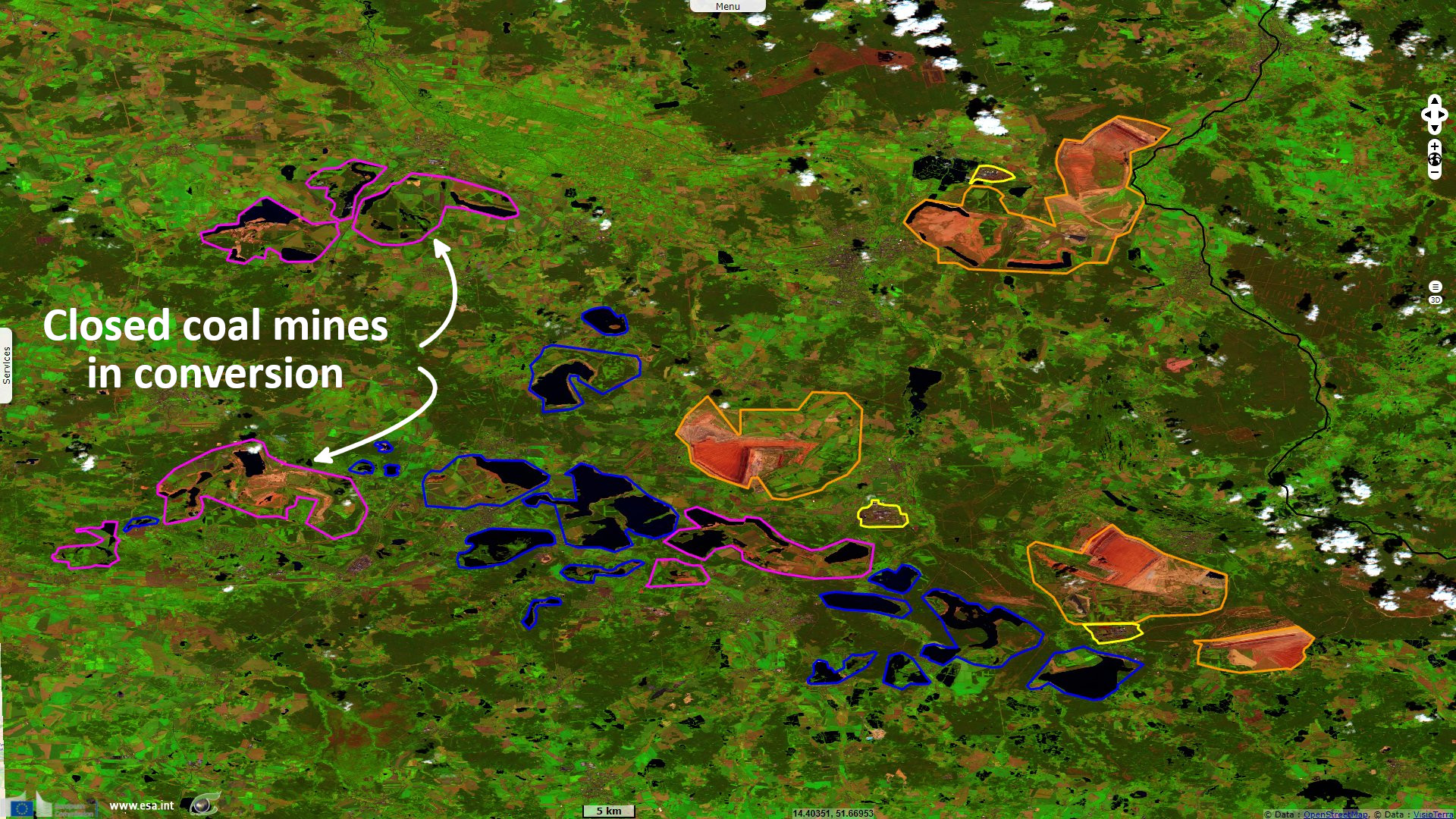Active lignite mines in Germany
Landsat TM acquired on 19 June 1984 from 09:55:49 to 09:56:13 UTC
...
Sentinel-2 MSI acquired on 08 September 2021 at 10:15:59 UTC
Sentinel-1 CSAR IW acquired on 11 October 2021 at 05:17:36 UTC
...
Sentinel-2 MSI acquired on 08 September 2021 at 10:15:59 UTC
Sentinel-1 CSAR IW acquired on 11 October 2021 at 05:17:36 UTC
Keyword(s): Mine, coal, greenhouse gas, climate change, fossile fuel, urban planning, Germany
As the price of natural gas is currently skyrocketing in Europe, other sources of energy become more profitable. The share of electricity produced from renewable energy in Germany has increased from 6.3 percent of the national total in 2000 to over 40 percent in 2019. Yet, while nuclear and fossil fuel are being phased out, coal was still used to generate almost 40% of Germany's electricity in 2018. On 26 January 2019, a group of federal and state leaders as well as industry representatives, environmentalists, and scientists made an agreement to close all 84 coal plants in the country by 2038.
Germany is also a major producer of coal, mostly lignite or brown coal. It is burned in coal plants near the mining areas to produce electricity since transporting lignite over far distances is not economically feasible; therefore, the plants are located near the extraction sites and pollution is not exported abroad as it is the case for gas or oil. As brown coal generates almost twice as much greenhouse gas emissions as gas for the same power, it explains 7 out of the 10 largest CO2 emitters in Europe are located in Germany, all of them coal power plants.
According to an science article written by Don Grant and published in IOP Science: "Combusting fossil fuels to produce electricity is the single largest contributor to sector-level, anthropogenic carbon pollution. As the global, fossil-fueled power sector has continued to grow, so too has the volume of carbon dioxide it emits into the atmosphere (International Energy Agency 2021). Over the past two decades, the electricity industry's CO2 emissions have risen by 53% worldwide (International Energy Agency 2021) and over half of all carbon releases are predicted to come from this sector in the future (Tong et al 2020). In the absence of an international cap-and-trade regime, several experts have argued that the next best approach for decreasing energy-related emissions is to set goals for electricity sectors' emission intensities, measured by the amount of CO2 emissions per megawatt (MWh) of electricity produced (Center for Clean Air Policy 2008, International Energy Agency 2009a, 2009b, Gerlak et al 2018)."
"While agreeing that this sectoral approach would be easier to implement than nationwide CO2 emission caps, others suggest it is still insufficiently targeted because some facilities release vastly more pollutants than others. According to them, a country's emissions could be mitigated significantly and without greatly disrupting the overall economy or threatening industry survival by reducing the discharges of a small group of extreme polluters (Freudenberg 2005, 2006, Collins et al 2020, Grant et al 2020, Pulver and Manski 2021). With respect to carbon pollution, some have suggested that the most effective way to address climate change is to take aim at the 'polluter elite,' individuals who own large shares of fossil fuel companies and/or are among the richest 10% of people in the world (Baer 2009, Chancel and Piketty 2013, Kennedy et al 2014). Others contend a better strategy would be to go after 'carbon majors,' the 100 companies responsible for supplying 70% of the world's fossil fuels (Heede 2014). Still other studies have examined organizations like power plants that directly burn and emit carbon."
The article concludes: "We find that countries' disproportionalities vary greatly and have mostly grown over time. We also find that 17%–49% of the world's CO2 emissions from electricity generation could be eliminated depending on the intensity standards, fuels, or carbon capture technologies adopted by hyper-emitting plants."
"Findings suggest that instead of relying on sweeping environmental initiatives, substantial environmental progress can be made through selectively targeting nations' hyper-polluters—the worst-of-the-worst—that are responsible for the lion's share of their carbon pollution. As the fossil-fuel-burning energy infrastructure continues to expand and the urgency of combating climate change grows, nations will likely need to consider more expedient strategies of this sort."
"As our results indicate, focusing on the most extreme polluters would yield varied benefits for nations. Therefore, no single disproportionality policy will fit all. In countries where larger emitters are difficult to regulate, it may be more effective to target a greater number of smaller plants. For example, in nations like China that have numerous mid-sized plants and therefore exhibit less disproportionately, it may be prudent to expand the range of targeted facilities from, say, the top 5% to the top 10%. Whatever the case might be, this study suggests that policies aimed at a small subset of super polluters should be considered alongside sector- or economy-wide approaches."












